|

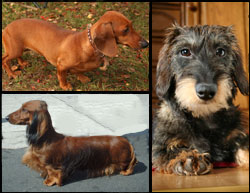 Proportions: A full-sized Dachshund averages 16 to 32 lb (7 to 14.5 kg), while the Miniature variety typically weighs less than 11 lb (5 kg). As early as the 1990s, owners' use of a third weight class became common, the "Tweenie", which included those Dachshunds that fell in between full and miniature, ranging from 10 to 15 lb (4.5 to 6.75 kg). Modern Dachshunds are characterized by their crooked legs, loose skin, and barrel-like chest, attributes that were deliberately added to the breed to increase their ability to burrow into tight spaces, as well as the long tail, which in hunting situations, is often used by the owner as a handle, to aid in extracting the Dachshund from the burrow hole after capturing its prey. They come in three coat varieties: Smooth, Longhaired, and Wirehaired; the Wirehaired variety is generally shorter in spine length than the other two. H. L. Mencken said that "A dachshund is a half-dog high and a dog-and-a-half long," which is their main claim to fame, although many poems and songs refer to them as "two dogs long". This characteristic has led them to be quite a recognizable breed and featured in many a joke and cartoon. Proportions: A full-sized Dachshund averages 16 to 32 lb (7 to 14.5 kg), while the Miniature variety typically weighs less than 11 lb (5 kg). As early as the 1990s, owners' use of a third weight class became common, the "Tweenie", which included those Dachshunds that fell in between full and miniature, ranging from 10 to 15 lb (4.5 to 6.75 kg). Modern Dachshunds are characterized by their crooked legs, loose skin, and barrel-like chest, attributes that were deliberately added to the breed to increase their ability to burrow into tight spaces, as well as the long tail, which in hunting situations, is often used by the owner as a handle, to aid in extracting the Dachshund from the burrow hole after capturing its prey. They come in three coat varieties: Smooth, Longhaired, and Wirehaired; the Wirehaired variety is generally shorter in spine length than the other two. H. L. Mencken said that "A dachshund is a half-dog high and a dog-and-a-half long," which is their main claim to fame, although many poems and songs refer to them as "two dogs long". This characteristic has led them to be quite a recognizable breed and featured in many a joke and cartoon.
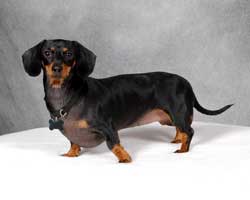 Coloring: Dachshunds have an enormous range of coloration. Dominant colors and patterns are red, or black & red, (the latter often being referred to informally as black & tan), but also occurring are cream, blue, wild boar, chocolate brown, fawn, and a lighter "boar" red. The reds range from coppers to deep rusts, with somewhat common coarse black hairs peppered along the back, tail, face, and ear edges, lending much character and an almost burnished appearance; this is often very desirable and is referred to among breeders and enthusiasts as "stag", or an "overlay". Solid black and solid chocolate-brown Dachshunds occur and, even though quite handsome, their colors are nonstandard; that is, the dogs are disqualified from conformance competitions in the U.S. and U.K. Older traditional patterns such as piebald and sable have recently been gaining popularity. Other color and pattern combinations have been developed; it is not uncommon to see Dachshunds with brown & red, chocolate & red, dapple, double dapple, and even white coats. Unfortunately, some of these colors require extensive inbreeding to obtain, and double dapples are often born eyeless or with severely underdeveloped eyes. Dapples of either kind usually sport light gray, light hazel, green or blue eyes, rather than the various shades of brown. Color aside, this eye condition has led to the double dapple coat being extremely disfavored among responsible breeders and owners. Coloring: Dachshunds have an enormous range of coloration. Dominant colors and patterns are red, or black & red, (the latter often being referred to informally as black & tan), but also occurring are cream, blue, wild boar, chocolate brown, fawn, and a lighter "boar" red. The reds range from coppers to deep rusts, with somewhat common coarse black hairs peppered along the back, tail, face, and ear edges, lending much character and an almost burnished appearance; this is often very desirable and is referred to among breeders and enthusiasts as "stag", or an "overlay". Solid black and solid chocolate-brown Dachshunds occur and, even though quite handsome, their colors are nonstandard; that is, the dogs are disqualified from conformance competitions in the U.S. and U.K. Older traditional patterns such as piebald and sable have recently been gaining popularity. Other color and pattern combinations have been developed; it is not uncommon to see Dachshunds with brown & red, chocolate & red, dapple, double dapple, and even white coats. Unfortunately, some of these colors require extensive inbreeding to obtain, and double dapples are often born eyeless or with severely underdeveloped eyes. Dapples of either kind usually sport light gray, light hazel, green or blue eyes, rather than the various shades of brown. Color aside, this eye condition has led to the double dapple coat being extremely disfavored among responsible breeders and owners.
Miniature Varieties: According to kennel club standards, the Miniature variety differs from the full-size only by size and weight, however, offspring from Miniature parents must never weigh more than the Miniature standard to be considered a Miniature as well.

They've Got Personality: Dachshunds are loyal, playful fun dogs, known for their propensity to chase small animals and birds with great determination and ferocity. Many dachshunds are a little strong headed, making them not as easy to train. According to the American Kennel Club's breed standards, "the Dachshund is clever, lively and courageous to the point of rashness, persevering in above and below ground work, with all the senses well-developed. Any display of shyness is a serious fault," and this would be a statement unanimously recognized by experienced owners. Their temperament and body language give the impression that they either do not know, or care, about their relatively small and comical stature. Individuals which are indulged may become snappy.
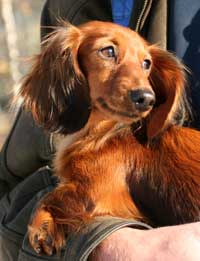 The Dachshund is known for his deep and soulful eyes and complex and telling facial expressions, the eyes having an "allure" that is quite commonly referenced in writings about the breed. Coat type is often considered to be associated with characteristic temperaments; the long-haired variety, for instance, is considered to be less excitable than the other types, having been cross-bred with the even-tempered Spaniel in order to obtain its characteristic long coat; however some who own long-haired Dachshunds might disagree with this statement. Because of the breed's characteristic barrel-like chest, the dachshund's lungs are unusually large, making for a sonorous and richly timbred bark that belies the dog's true size. The Dachshund is known for his deep and soulful eyes and complex and telling facial expressions, the eyes having an "allure" that is quite commonly referenced in writings about the breed. Coat type is often considered to be associated with characteristic temperaments; the long-haired variety, for instance, is considered to be less excitable than the other types, having been cross-bred with the even-tempered Spaniel in order to obtain its characteristic long coat; however some who own long-haired Dachshunds might disagree with this statement. Because of the breed's characteristic barrel-like chest, the dachshund's lungs are unusually large, making for a sonorous and richly timbred bark that belies the dog's true size.
Back Problems: The breed is known to have spinal problems, due in part to an extremely long spinal column and short rib cage. The risk of injury can be worsened by obesity, which places greater strain on the vertebrae, but many an owner with an injured, skinny Dachshund will confirm that these problems are largely genetic. In order to prevent injury, it is recommended that Dachshunds be discouraged from jumping and taking stairs, and the importance of holding the dog properly cannot be stressed enough. Many veterinarians, however, indicate that as long as the Dachshund takes the stairs slowly, the dog's spine will manage just fine.
How to Hold Your Dachshund: The Dachshund should only be picked up when both front and rear portions of the body are fully supported. A good technique is the typical "football carry" used by running backs or others in a game when rushing the ball, with the dog tucked underneath the arm, against the body, and supported along the length of the carrier's bent arm, hand under the upper chest, and tail near the elbow. This method supports the weight of the rear body, preventing wiggling and twisting of the dog to right itself.
How to Treat Back Problems: As it has become increasingly apparent that the occurrence and severity of these spinal problems, or intervertebral disk disease, is largely hereditary, responsible breeders are working to eliminate this characteristic in the breed. Treatment consists of various combinations of crate confinement and courses of anti-inflammatory medications (steroids), and may even lead to surgical intervention to remove the troublesome disk(s). Other treatments that have been used with some success include TENS, acupuncture, physical therapy, moxibustion, chiropractic manipulation, and massage. The use of arthritis medication such as Rimadyl, (which failed clinical trials for humans), has reverted to the subjects of its previous testing: dogs, with great results in relieving skeletal back pain.

Dachshund History: Some have theorized that the early roots of the Dachshund go back to Ancient Egypt, where engravings were made featuring short-legged hunting dogs. But in its modern incarnation, the Dachshund is a creation of European breeders, and includes elements of German, French, and English hounds and terriers. 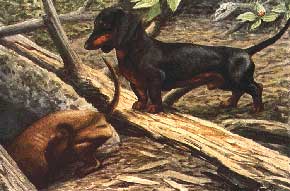 Dachshunds have been kept by royal courts all over Europe, including that of Queen Victoria, who was particularly enamored of the breed. Dachshunds have been kept by royal courts all over Europe, including that of Queen Victoria, who was particularly enamored of the breed.
The first verifiable references to the Dachshund, originally named the "Tachs Kriecher" (badger crawler) or "Tachs Krieger" (badger catcher), come from books written in the early 1700s. Prior to that, there exist references to "badger dogs" and "hole dogs", but these likely refer to purposes rather than to specific breeds. The original German Dachshunds were larger than the modern full-size variety, weighing between 30 and 40 lb (14 to 18 kg), and originally came in straight-legged and crook-legged varieties (the modern Dachshund is descended from the latter). Though the breed is famous for its use in exterminating badgers and badger-baiting, Dachshunds were also commonly used for rabbit and fox hunting, for locating wounded deer, and in packs were known to hunt game as large as wild boar and as fierce as the wolverine.
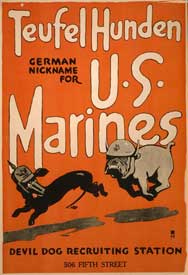 Symbol of Germany: Dachshunds have traditionally been viewed as a symbol of Germany, despite their pan-European heritage. During World War I the animals -- a favorite of Kaiser Wilhelm II -- fell so far out of favor in England and the United States that Dachshunds were stoned to death in the streets. Many Americans began referring to Dachshunds as "liberty pups", and political cartoonists commonly used the image of the Dachshund to ridicule Germany. The stigma of the association was revived to a greatly reduced extent during World War II, and it quickly faded away following the war's end. German Field Marshal Erwin Rommel was also known for keeping Dachshunds. The Dachshund for this association with Germany was chosen to be the first official mascot for the 1972 Summer Olympics with the name "Waldi". Symbol of Germany: Dachshunds have traditionally been viewed as a symbol of Germany, despite their pan-European heritage. During World War I the animals -- a favorite of Kaiser Wilhelm II -- fell so far out of favor in England and the United States that Dachshunds were stoned to death in the streets. Many Americans began referring to Dachshunds as "liberty pups", and political cartoonists commonly used the image of the Dachshund to ridicule Germany. The stigma of the association was revived to a greatly reduced extent during World War II, and it quickly faded away following the war's end. German Field Marshal Erwin Rommel was also known for keeping Dachshunds. The Dachshund for this association with Germany was chosen to be the first official mascot for the 1972 Summer Olympics with the name "Waldi".
Wiener Racing: Some people train and enter their Dachshunds to compete in Dachshund racing, such as the Wiener Nationals. Several races across the country routinely draw several thousand attendees, including races in Buda, TX, Los Alamitos, CA, and Findlay, OH. Despite the popularity of these events, the Dachshund Club of America opposes "wiener racing", as many greyhound tracks use the events to draw large crowds to their facilities. The DCA also is worried about potential injuries to dogs, due to their predisposition to back injuries.
Earthdog Trials: Another favorite sport is earthdog trials, in which dachshunds enter tunnels with dead ends and obstacles attempting to locate an artificial bait or live but 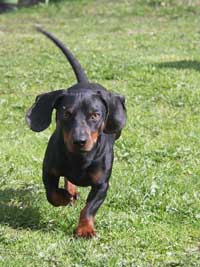 caged and protected mice. Dachshunds, being true scent hounds, also compete in scent tracking events, with a national championship sponsored every year by the DCA. caged and protected mice. Dachshunds, being true scent hounds, also compete in scent tracking events, with a national championship sponsored every year by the DCA.
Hot Dog Name Sake: The naming of the modern American hot dog is supposedly influenced by the Dachshund. In 1852, the butcher's guild in Frankfurt-am-Main created a smoked, spiced sausage in a thin casing, dubbed a "little-dog" or "dachshund sausage" for its obvious resemblance to the low-riding German dog. The popular legend on the etymology of hot dog holds that a cartoonist named Tad Dorgan attended a polo match in New York in 1901 where vendors roamed the aisles imploring patrons to "get your red-hot dachshund sausages." Enchanted, Dorgan drew a smiling dachshund nestled in a long bun, but couldn't spell dachshund, so he captioned it "hot dog!" and thus the food got its name. Although charming, this legend has never been confirmed.
Popular Pooch: Dachshunds are a popular pet in the United States, ranking 5th most common dog breed. They are a popular dog among apartment dwellers, vying with the poodle for rank as the most common breed in New York City in recent years. One will find varying degrees of organized local Dachshund clubs in most major American cities, including New York, New Orleans, Los Angeles, and Chicago. American 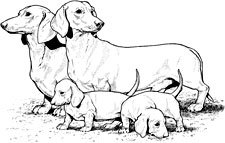 Dachshund enthusiasts will enjoy their visits to overseas, as
the breed's popularity is legion in places such as Germany, France, Switzerland, Dachshund enthusiasts will enjoy their visits to overseas, as
the breed's popularity is legion in places such as Germany, France, Switzerland,
Hungary, and Japan.
Famous Dachshunds:
--"Lump", the pet of Pablo Picasso who was thought to have inspired much of his work.
--"Odie", Jon's dog in the Garfield comic strip.
--"Schnitzel von Krumm" (with the very low tum) (fictional), appearing in the Hairy Maclary books by New Zealand author Lynley Dodd.
--Wadl and Hexl, Kaiser Wilhelm II's famous ferocious pair. Upon arriving at archduke Franz Ferdinand's country seat, château (castle) Konopiste, on a semi-official visit, they promptly proceeded to do away with one of the Austro-Hungarian Crownprince's priceless golden pheasants, thereby almost causing an international incident!
--"Hot Dog" (fictional) in Krypto the Superdog.
--"Schotzie" in That 70s Show.
--In the comic strip Drabble (comic), the family's dachsund Wally is often the subject of gags related to his short legs.
--"Wiener Dog" in The Norm Show.
--"Itchy Itchiford" In All Dogs Go to Heaven.
--"Boots" in Emergency!
--"Little Dog" in 2 Stupid Dogs.
--"Oscar" in the comic strip Liberty Meadows.
--"Slinky" in Toy Story.
--"Buster" in Toy Story 2.
--Duke Junjun Sarmiento.
--Oscar, the hero in the goofy costume from The Hallo-wiener by children's author David Pilkey.
All text is available under the terms
of the GNU Free Documentation License
|
